QuestionQUESTION: Hi Diane: I have a female Leopard Gecko and I was wondering if you could provide a picture of your terrarium set-up. Right now we have a 10 gal. tank and want to buy her a 20 gal. We are looking for ideas to provide her with the best habitat possible. Also, she does not want to eat crickets, so we have been giving her mealworms exclusively. Thanks, Brad
ANSWER: Hi Brad,
On her not eating crickets...try breaking the hind legs on the crickets, they still move, but don't jump...she may not like the "chase". With mealworms, if you reaise your own,which is very very easy, you can feed her the fresh shed ones, which are better as they don't have the hard outer body. They are the ones that are nice and white. Also, try superworms(NOT giant mealworms) if your leo is big enough to eat a super worm. Some places do sell younger superworms which aren't as large.
Its great you want to go to a 20 gallon tank...much easier to set up for temperatures, etc. I don't have good pictures of my leos setup..but...here is a link that shows what you need...
http://www.drsfostersmith.com/pic/article.cfm?aid=2203 (although it only shows two hides...using at least 2 plus the humid hide is better)
http://www.paw-talk.net/forums/f89/leopard-gecko-tanks-37933.html
http://www.monsterfishkeepers.com/forums/showthread.php?t=207797
I don't remember if I sent you my basic care sheet so I am including it here...sorry if you already received it.
Basically... you want it safe for your leo...appealing to your eye..
practical to clean..
You want 3 temperature zones
no sand or other loose substrate
a humid hide on the warm end
a dry hide on the warm end
a dry hide on the cool end
a dry hide in the middle(if desired)
safe low climbing branches/plants
and of course your dishes, lights, etc
If you do a google search on "leopard Gecko tank setups" and click "pictures" you will get some good ideas...also, looking at bearded dragon setups will also give you great ideas. Just remember..no sand or other barks, litter..etc..which many of the pictures will show them using one of the not recommended substrates.
BASIC CARE FOR A LEOPARD GECKO
Leopards are pretty easy to care for but they do need
special care. Here are some of the basic needs of your gecko.
HOUSING: The need to have at least a 20 gallon long tank for one Leo. This needs to have a secure fitting screen top...they can be quite the escape artists!!! They need to have a humid hide box.You can make this with something as simple as a small plastic dish with a hole cut in one side and a small mesh bag filled with some Sphagnum moss coconut bark or Peat moss that you mist.
I made mine out of the small plastic folgers coffee containers...I cut an opening in the lid..and put the moss in..they LOVE it. I use the terrarium moss in mine.
I use that on the warm side of the tank. Be sure to provide a cool hidebox on the other end. I also provide a mid temperature hide...which is in the middle of the tank.I use the critter caves which you can purchase. NOT the ones that have heat in them!!!!
Provide secure climbing areas for your gecko. Fake plants, rocks and branches are all fine to use. be sure there are no wires or sharp ends to any fake plants you use.
*****SUBSTRATE:(that's the stuff on the floor of your tank) Newspaper, lizard carpet or paper towels work great and are easy to clean and are much safer than any loose substrate. Sand or other loose substrate is not recommended as that they can be deadly to the leo when it is ingested(eaten, even by accident while eating their insects)...A very graphic site of an impacted leo surg can be seen at http://homepage.mac.com/exoticdvm/reptile/PhotoAlbum181.html it is very graphic!!! ******What I have found that works great for safety and heat distribution is using about 1/4 inch of childrens play sand(since the tiles fit tight together, there is no sand danger) on the bottom of the tank and on top that you place ceramic or slate floor tile. What is nice is that the 12 x 12 squares fit perfect in a 20 gallon tank with no spaces between the tiles. The sand and the tile distribute the heat wonderfully. Using the under tank heater as described is what distributes the heat. Also, overhead heat will help in heating the tiles...I've been using this set up for several years and the leos love it. Using a tile that isn't smooth is recommended. **********
TEMPERATURES: They need a warm area of 88-92 degrees and a
cooler area in the upper 70s, low 80s. At night their temperature can drop to the low to mid 70's.
Never use a hot rock for a leopard gecko...or any reptile.
They can severely burn any reptile. You can use a heating
pad under the tank,under tank heater, or you can use a regular household lightbulb in a dome fixture with a ceramic socket in it to keep the warm area at the 88-92 degree area.At night, no white light. If room temperatures stay above 70 degrees, no extra night heat is needed. The undertank heater or heating pad should cover about 1/3 of the tank....be sure to raise the tank up about 1/4-1/2 inch off the stand when using an undertank heat source to prevent heat build up which can cause the glass to break and hot spots in the glass. Be sure to have a good layer of newspaper, carpeting or, even a thin flat rock(such as tile) on top the area that the undertank heat source is placed...if you use a thin rock or tile, it helps to distribute the heat very well.
You can use the special nighttime lights that are designed for reptiles. I like using a ceramic heat emitter on a thermostat for nighttime heat.
DO NOT use black lights or party lights as they can cause eye damage!!!!
The wattage you use will vary based on room temperature and size of tank.
LIGHTING: Leopard geckos do not need UVB lighting but it does not hurt them to give them uvb. They should have some type of light during the day, be it a uvb tube, regular florescent light, reptile day light or regular household lightbulb. NO white lights at night!!!
FEEDING: Geckos should not be fed crickets or other insects that are bigger than the space between their eyes. Generally, hatchlings can be fed more than once a day,juvys can be fed twice a day, adults are fed once daily or every other day, in the early evening. Crickets and other food items such as silk worms, super, and an occasional treat of a wax worm, need to be dusted with a calcium supplement two times a week and also they should have a small dish of calcium in their tank. I use the lid of a milk jug for the little dish of calcium in their tank. For dusting the insects, Use a calcium with no added phosphorus. Insects must be gut loaded(fed) for at least 48 hours prior to feeding your gecko. Remove any uneaten crix or superworms after 15-20 minutes..... Place a piece of cut potato in the tank so that if you have missed any uneaten insects, they will eat the potato instead of nibbling on your gecko!!!
*************You have to be sure to feed your crickets and insects the right foods before feeding them to your gecko. If your crickets/insects are not healthy and well fed, your gecko will not get the nutrition he needs. You can gut load your crickets and insects greens, veggies, cereals or specially designed commercial foods for crickets or the insects you are feeding. ************
Be sure to have a small dish of clean water for your gecko at all times!!
You can offer them some baby food or fruits on occasion ...
Mine will even eat a small piece of watermelon now and then.WATER: always provide a dish of drinking water. If you choose to mist your gecko to drink, its best to not get the tank too wet as that they do not do well with higher humidity. Sometimes its better to take your leo out of their tank to mist them to get them to drink!!!
HANDLING: Some geckos enjoy being held...others prefer not to be handled at all. Be sure to be very gentle when holding your leo and NEVER grab them by the tail! Their tails are extremely fragile and will break.
I do suggest finding a vet that can treat reptiles BEFORE you actually need one!!! To find a vet that is able to care for reptiles:
http://www.herpvetconnection.com
http://www.arav.org/ECOMARAV/timssnet/amm/tnt_mdsearch.cfm
http://www.anapsid.org/vets/
For more information on leopard geckos:
http://www.drgecko.com
If you have any questions or don't understand something, please let me know.
---------- FOLLOW-UP ----------
QUESTION: Hi Diane: Thanks for your response. I have 3 more questions. 1 - Is it necessary to have a night glo moonlight lamp. Someone recommended it. 2 - I have an under-the-tank heater. The temperature where my Leo lies is in the mid 90's in the center and high 80's on the sides of the tank. She seems to be pretty happy with this set-up for the past 2 years. The temperature in the tank is about 82. Do I need to raise the tank temperature? 3 - My Leo gets natural indirect sunlight during the day. Do I still need to give her artificial light such as a fluorescent or soft white incandescent? Thanks for your help. Brad
AnswerHi Brad,
I don't use night lights for mine...its up to you. Some people do, some people don't.
If she seems happy, and the temperature is staying in the mid 90's(88-92 is recommended) and she is doing well with eating,(nice fat tail,etc)then its fine. What happens when the temperatures are too high is their foods digest too fast and they don't get the nutrition they need...when temperatures are too slow, their foods digest to slow and nutrition is lost.
Your temperatures are fine...just be sure that she has cooler area at night...generally when you have the basking(warm) temperature correct, the rest of the temperatures fall right where needed when you are using the 20 gallon long tank. With the undertank heaters, they should only cover about 1/3 of the tank, generally one end.
If she has indirect sunlight, which is lighting her tank up nicely, then you shouldn't need additional lighting...it might be a good idea to have one on hand though for cloudy days. Also, watch as the (sun)seasons/temperatures change so she isn't getting too much heat from the sun.

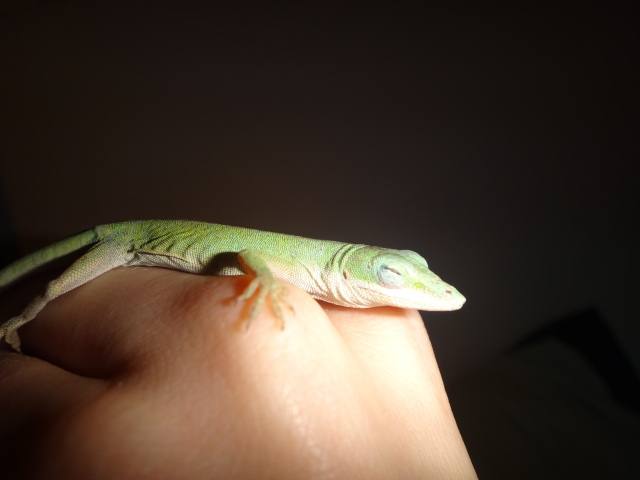 Green Anole with possible eye infection
QuestionQUESTION: I have 5 anoles in a 20 gallon tank w
Green Anole with possible eye infection
QuestionQUESTION: I have 5 anoles in a 20 gallon tank w
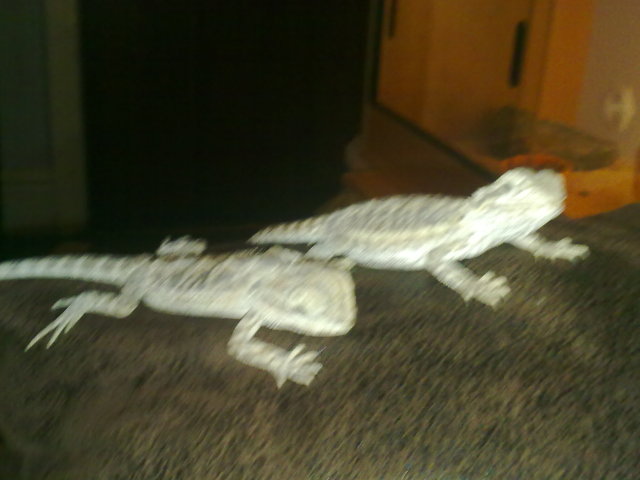 Bearded Dragon size
Question
Eddie Lizard & Lizzie
My son got 2 Bearde
Bearded Dragon size
Question
Eddie Lizard & Lizzie
My son got 2 Bearde
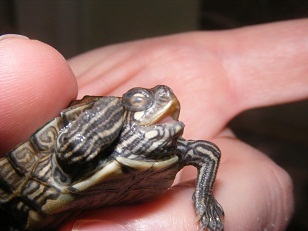 my turtles mouth
Question
my turtle
my baby turtle as a mouth problem, I
my turtles mouth
Question
my turtle
my baby turtle as a mouth problem, I
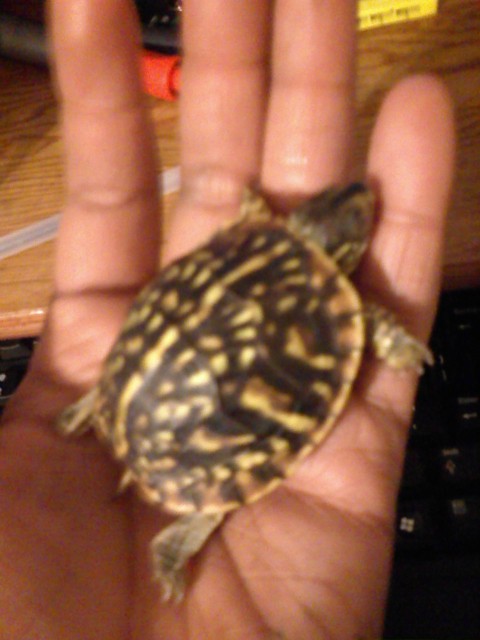 i need help with my baby turtle
Question
my turtle
my baby turtle is brown and yellow a
i need help with my baby turtle
Question
my turtle
my baby turtle is brown and yellow a
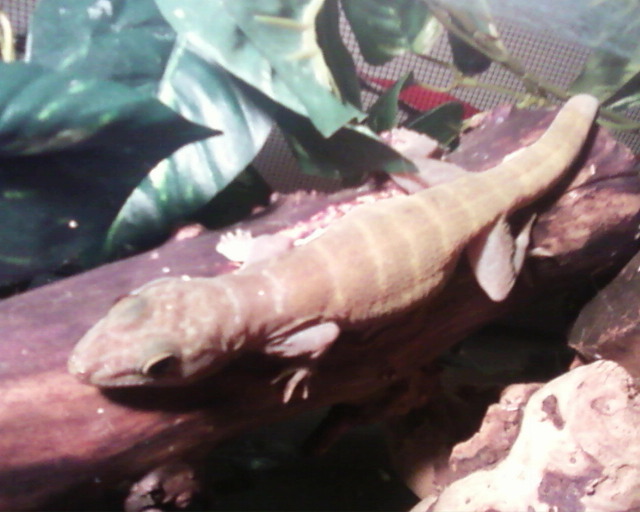 Identify
Question
Moody
I recently adopted 3 gecko/lizards from
Identify
Question
Moody
I recently adopted 3 gecko/lizards from